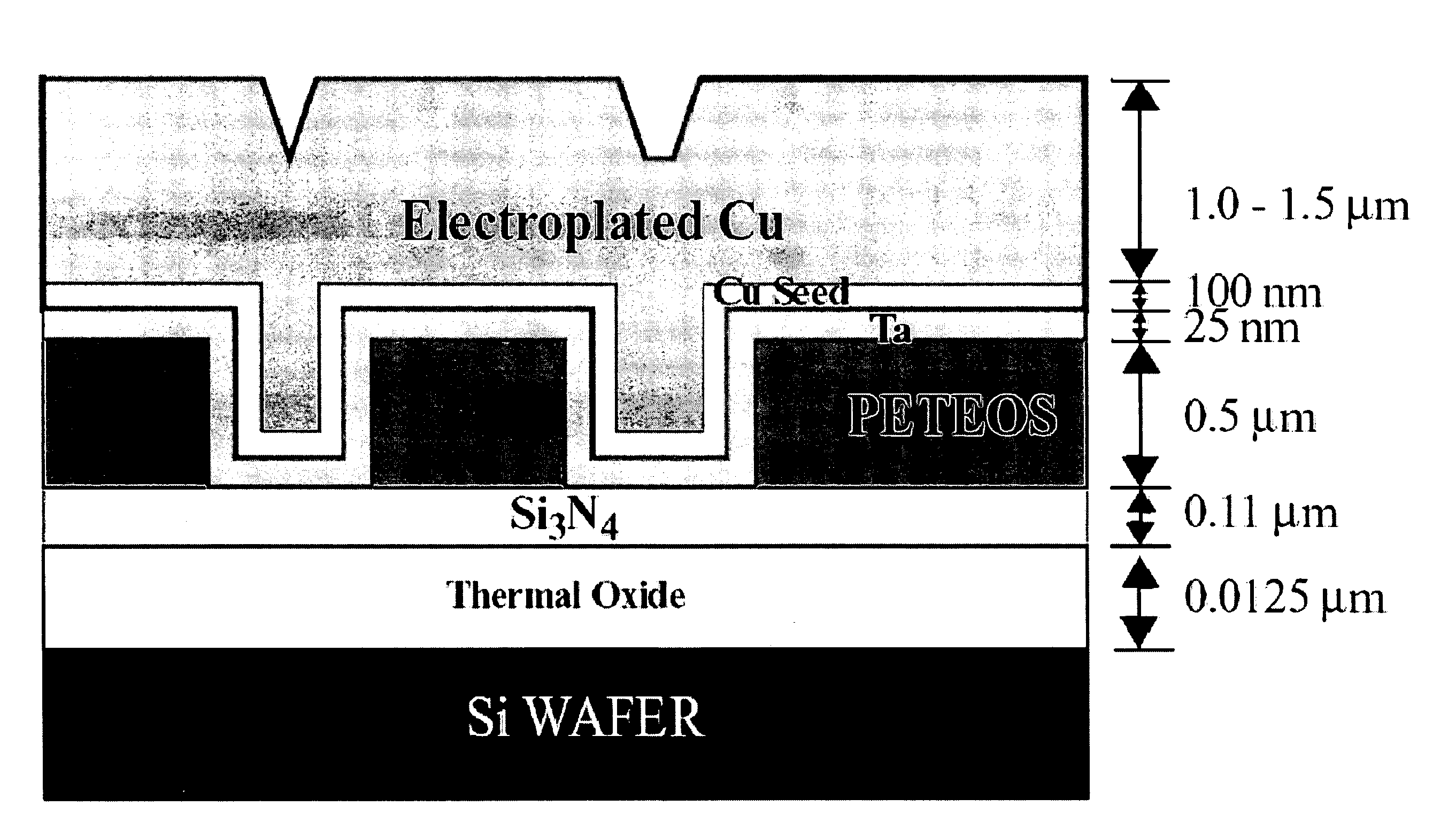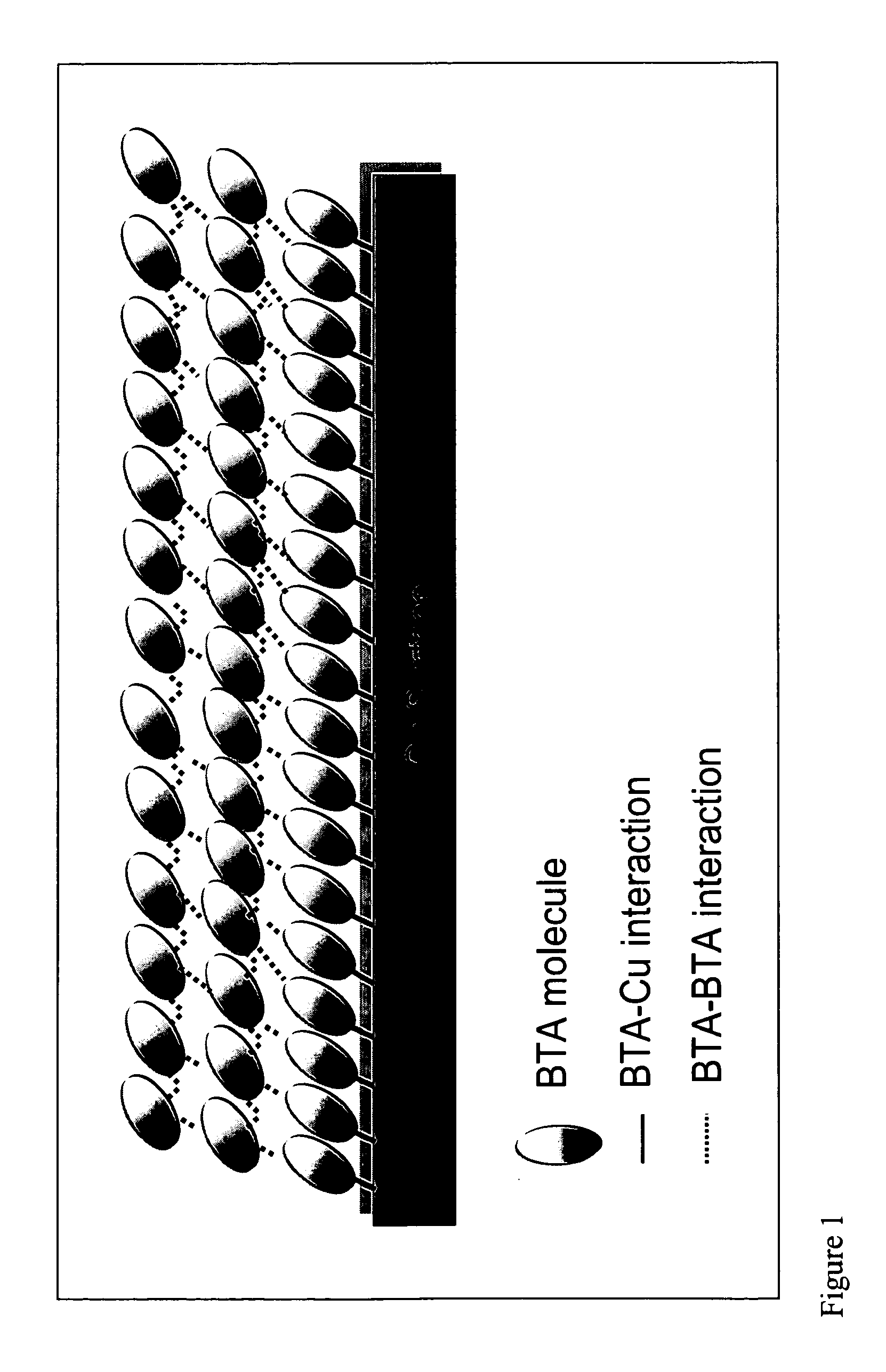Controlling passivating film properties using colloidal particles, polyelectrolytes, and ionic additives for copper chemical mechanical planarization
a technology of chemical mechanical planarization and passivating film, which is applied in the direction of copper compounds, chemistry apparatus and processes, other chemical processes, etc., can solve the problems of high step height reduction efficiency and meaningful material removal, and achieve the effect of reducing the bta film thickness and increasing the static etch ra
- Summary
- Abstract
- Description
- Claims
- Application Information
AI Technical Summary
Benefits of technology
Problems solved by technology
Method used
Image
Examples
example 1
Standard CMP Solution
[0057]Two abrasive free CMP solutions were prepared which contain 1% glycine as complexing agent and 1% hydrogen peroxide as oxidizer. To one solution, 1 mM of BTA was also added as passivating agent. The solutions were adjusted to pH 6, 5, and 4 using hydrochloric acid or nitric acid.
TABLE 1Static etch rate for an abrasive free CMP solution that contains 1%glycine as complexing agent and 1% hydrogen peroxide as oxidizer.1% glycine1% hydrogen peroxide0.001 mol / L BTAWithout BTA(H2O2)SER(nm / min)SER(nm / min)pHpH = 4.00130120adjusted bypH = 5.0096121HClpH = 6.0018135pHpH = 4.0038134adjusted bypH = 5.008124HNO3pH = 6.007115
[0058]As shown in Table 1, the static etch rates are almost constant for those solutions without BTA at all pH's. This is due to the fact that, without BTA as passivating agent, the static etch rate is limited by the dissolution power of the complexing agent and the protection of the native copper oxide film which is thin and porous.
[0059]The effect...
example 2
CMP Solution with Sodium Chloride
[0061]A set of abrasive free solutions as described in Example 1 were prepared. The solution contains various amounts of sodium chloride. The BTA concentration in solution was monitored using an UV / Vis spectrometer for the samples before and after they are exposed to a fixed amount of copper powders. The concentration of BTA decreases due to the surface adsorption phenomenon. Based on the total loss of BTA from solution and the surface area of the copper powders, the thickness of the BTA film formed on the copper surface can be estimated. As shown in FIG. 2, the presence of chloride ions leads to an increase in total thickness of the passivating film.
[0062]Considering the fact, as described in Example 1, that the chloride ion also leads to an increase in static etch rate, one must conclude that the BTA passivating film in the presence of chloride ions must be more porous and less effective. Such a change in passivation effectiveness can also be clear...
example 3
Effect of BTA on Chloride Ions
[0063]A potential disadvantage of the presence of chloride ions in a copper CMP slurry is its corrosiveness or increase static etch rate. It has been demonstrated that the static etch rate can be controlled by having enough free BTA in the solution. More specifically, as shown in FIG. 4, at high concentration of BTA the static etch rate actually decreases in the presence of chloride. A set of polishing experiments were carried out using slurries containing chloride ions. As shown in FIG. 5, there is no sign of corrosion spots on the polished patterned wafers using a slurry that contains chloride ions.
PUM
| Property | Measurement | Unit |
|---|---|---|
| pH | aaaaa | aaaaa |
| thick | aaaaa | aaaaa |
| pH | aaaaa | aaaaa |
Abstract
Description
Claims
Application Information
 Login to View More
Login to View More - R&D
- Intellectual Property
- Life Sciences
- Materials
- Tech Scout
- Unparalleled Data Quality
- Higher Quality Content
- 60% Fewer Hallucinations
Browse by: Latest US Patents, China's latest patents, Technical Efficacy Thesaurus, Application Domain, Technology Topic, Popular Technical Reports.
© 2025 PatSnap. All rights reserved.Legal|Privacy policy|Modern Slavery Act Transparency Statement|Sitemap|About US| Contact US: help@patsnap.com



